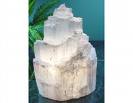Namibia´s varied geology encompasses rocks of Archaen to Phanerozoic age, thus covering more than 2600 million years of earth history. Nearly half of the country´s surface area is bedrock exposure, while the remainder is covered by young surficial deposits of the Kalahari and Namib Deserts.
Geologie Namíbie
Namibia's Metamorphic inliers consisting of highly deformed gneisses, amphibolites, metasediments and associated intrusive rocks occur in the central and northern parts of the country, and represent some of the oldest rocks of Palaeoproterozoic age (ca. 2200 to 1800 Ma) in Namibia. The Kunene and Grootfontein Igneous Complexes in the north, the volcanic Orange River Group and the Vioolsdrif Granite Suite in the south, as well as the volcanosedimentary Khoabendus Group and Rehoboth Sequence also belong to this age group.
The Mesoproterozoic
The Mesoproterozoic (1800 to 1000 Ma) is represented by the Namaqua Metamorphic Complex, which comprises granitic gneisses, metasediments and granitic/metabasic intrusions, and by the volcanosedimentary Sinclair Sequence of central Namibia, with its associated granites (e.g. Gamsberg Suite).
The Proterozoic
The coastal and intracontinental arms of the late Proterozoic Damara Orogen (800 to 500 Ma) underlie large parts of northwestern and central Namibia, with stable platform carbonates in the north and a variety of metasedimentary rocks pointing to more variable depositional conditions further south. Along the southwestern coast, the volcanosedimentary Gariep Belt is interpreted as the southern extension of the Damara Orogen. During the later stages of orogenic evolution the shallow-marine clastic sediments of the Nama Group, which covers much of central southern Namibia, were derived from the uplifted Damara and Gariep Belts.
The Perm
Sedimentary and volcanic rocks of the Permian to Jurassic Karoo Sequence occur in the Aranos, Huab
 and Waterberg Basins, in the southeastern and northwestern parts of the country. They are extensively intruded by dolerite sills and dyke swarms, which in collusion with predominantly basaltic volcanism (e.g. Etendeka Plateau) and a number of alkaline subvolcanic intrusions (e.g. Brandberg, Spitzkoppe, Erongo), mark the break-up of Gondwana, and the formation of the South Atlantic ocean during the Cretaceous. The currently last chapter of Namibia´s exciting geological history is represented by the widespread Tertiary to Recent (less than 50 Ma) sediments of the Namib and Kalahari Sequences.
and Waterberg Basins, in the southeastern and northwestern parts of the country. They are extensively intruded by dolerite sills and dyke swarms, which in collusion with predominantly basaltic volcanism (e.g. Etendeka Plateau) and a number of alkaline subvolcanic intrusions (e.g. Brandberg, Spitzkoppe, Erongo), mark the break-up of Gondwana, and the formation of the South Atlantic ocean during the Cretaceous. The currently last chapter of Namibia´s exciting geological history is represented by the widespread Tertiary to Recent (less than 50 Ma) sediments of the Namib and Kalahari Sequences.Targets for mineral exploration have been identified throughout the stratigraphic column. Metamorphic complexes host a variety of prospective environments, such as copper-molybdenum porphyry, volcano-exhalative base metals and gold, volcanogenic copper, sedimentary-exhalative lead-zinc, shear-zone gold and beryllium-niobium-tantalum pegmatites. Meso- to Neoproterozoic rocks locally contain extensive red-bed copper, while calc-alkaline granitoid intrusives of that age have potential for porphyry and hydrothermal copper, as well as for vein-type gold mineralisation.
The Neoproterozoic
In the Neoproterozoic Damara Orogen and Gariep Belt, mineralisation is associated with successive phases of intracontinental rifting (copper, graphite), spreading and the formation of passive continental margins (volcano-exhalative base metals, e.g. Rosh Pinah, Skorpion; sedimentary-exhalative lead-zinc, eg. Tsongoari; glaciomarine iron-manganese, e.g. Otjosondu. Besshi-type copper-pyrite (e.g. Otjihase) is related to mid-ocean ridge development, whereas subsequent subduction led to the localised enrichment of carbonate-hosted base metals (e.g. Tsumeb and Kombat), uraniferous granites (Rössing), rare metal and tin pegmatites (Uis, Rubicon), as well as skarn tungsten and gold (Navachab).
Coal and diamonds
 Coal measures are hosted in Permian rocks of the Karoo Sequence, while Cretaceous anorogenic complexes, contain a variety of semi-precious stones, fluorite (Okorusu), apatite, rare earth elements, iron and base metals. Following the discovery of the offshore Kudu gas field of Cretaceous age, recent hydrocarbon exploration also intersected oil-prone source rocks in boreholes. Tertiary epigenetic uranium mineralisation occurs in calcretes above basement rocks, while salt is produced by solar seawater evaporation (e.g. Walvis Bay and Swakopmund Salt Works).
Coal measures are hosted in Permian rocks of the Karoo Sequence, while Cretaceous anorogenic complexes, contain a variety of semi-precious stones, fluorite (Okorusu), apatite, rare earth elements, iron and base metals. Following the discovery of the offshore Kudu gas field of Cretaceous age, recent hydrocarbon exploration also intersected oil-prone source rocks in boreholes. Tertiary epigenetic uranium mineralisation occurs in calcretes above basement rocks, while salt is produced by solar seawater evaporation (e.g. Walvis Bay and Swakopmund Salt Works).The major growth area of Namibia´s mining industry, however, is offshore diamond mining, with the country featuring among the world´s top five producers. The Tertiary to Quaternary diamondiferous deposits are currently exploited along the southwestern coast, both off - and onshore, employing techniques, which are used nowhere else in the world.
Geological map:http://www.mme.gov.na/gsn/simplegeomap.htm
More on resources: http://www.mme.gov.na/gsn/pdf/miningjournal.pdf
ZDROJ: Geological Survey of Namibia
Sdílet článek na sociálních sítích
